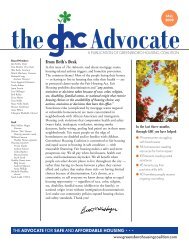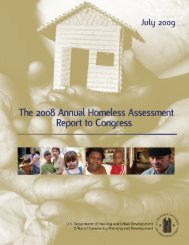Ten Year Plan to End Chronic Homelessness - Greensboro Housing ...
Ten Year Plan to End Chronic Homelessness - Greensboro Housing ...
Ten Year Plan to End Chronic Homelessness - Greensboro Housing ...
Create successful ePaper yourself
Turn your PDF publications into a flip-book with our unique Google optimized e-Paper software.
James M.<br />
A 60 year old black male, James was on the streets for 20 years. He is an<br />
alcoholic and has spent a great deal of time in jail and in hospital de<strong>to</strong>x<br />
settings, eventually suffering seizures and kidney problems. He often supported<br />
himself by forgery or shoplifting, leading <strong>to</strong> arrests and jail time.<br />
Now housed, he is in recovery and participates in ongoing outpatient substance<br />
abuse treatment.<br />
During the years 2001 through 2004, while homeless, he utilized services<br />
costing a <strong>to</strong>tal of $191,280, or an average annual cost of $47,820; since<br />
being housed, his annual average has been $24,900.<br />
Leo J.<br />
Leo is a 43 year old white male who has had severe problems with alcoholism,<br />
including suffering seizures. He has been through at least 11 de<strong>to</strong>x<br />
and treatment programs. He was housed in 2006, but has since returned<br />
<strong>to</strong> living on the streets, with time in hospitals, substance abuse treatment<br />
facilities, and jails. While homeless during 2001 through 2005, he utilized<br />
services costing $246,090, or an average annual cost of $49,218; while he<br />
was housed, he used services costing $21,975 annually.<br />
Larry B.<br />
A 39 year old black male, he spent four years in Central Prison, where he<br />
was diagnosed as HIV positive. He was released <strong>to</strong> transitional housing,<br />
but was not successful there and had <strong>to</strong> leave. Then he had several hospitalizations<br />
and arrests and spent time homeless and in shelters. In 2005,<br />
his advancing kidney disease led <strong>to</strong> the need <strong>to</strong> begin dialysis, which he<br />
still continues. When he was able <strong>to</strong> apply for permanent housing, the<br />
required police report was 28 pages long. During his time homeless from<br />
2001 through 2005, he had a <strong>to</strong>tal service cost of $220,644, or an average<br />
annual cost of $44,129; housed, his average annual cost has been $60,545<br />
(primarily due <strong>to</strong> ongoing dialysis and medical care).<br />
Melvin B.<br />
A 50 year old white male, Melvin is an alcoholic for whom the physical<br />
<strong>to</strong>ll of many years of constant alcohol use and abuse led <strong>to</strong> a stroke. The<br />
stroke resulted in paralysis of his left arm and leg and a speech impediment.<br />
He spent several years in rehabilitation and is now sober and mobile<br />
although he continues <strong>to</strong> have a speech impediment and is unable <strong>to</strong> lift<br />
heavy objects. He is able <strong>to</strong> live independently in permanent housing and<br />
receives disability payments as income but still requires some medical services.<br />
While homeless during 2001 through 2004, he used a <strong>to</strong>tal of<br />
$207,300 in services, or an average annual cost of $51,825; since being<br />
housed in 2005, his average annual cost of services has been $25,525.<br />
Bill J.<br />
A 51 year old black male, he spent time in jails, emergency shelter, and<br />
substance abuse de<strong>to</strong>x treatment; he was diagnosed as HIV positive in<br />
2002. He eventually moved <strong>to</strong> a permanent apartment in 2004. He is now<br />
a “success s<strong>to</strong>ry” whose case manager notes that since moving <strong>to</strong> permanent<br />
housing and receiving services, he has remained stable, sober, and<br />
out of trouble. He does volunteer work <strong>to</strong> help others, and celebrates New<br />
<strong>Year</strong>’s Eve (formerly a big party night for him) by attending an Alcoholics<br />
Anonymous meeting or church service. While homeless from 2002<br />
through 2003, he utilized services costing a <strong>to</strong>tal of $49,800 or an average<br />
annual cost of $24,900; while housed in 2005 and 2006 his average annual<br />
cost was $15,884.<br />
Although these eight cases do not comprise a scientific sample of the chronically<br />
homeless, their his<strong>to</strong>ries show the high human cost of homelessness,<br />
and the related community resource costs of dealing with their crises. Their<br />
s<strong>to</strong>ries track the conclusions reached by other communities through various<br />
analyses of service usage by chronically homeless individuals.<br />
The financial amounts shown indicate the heavy usage of community<br />
resources by the chronically homeless. Dr. Steve Cure<strong>to</strong>n, Professor of<br />
Sociology at the University of North Carolina at <strong>Greensboro</strong>, notes:<br />
…homelessness indicates that there is a problem with social regulation and<br />
social order…homelessness as a condition represents a visual stain for a<br />
community that continues <strong>to</strong> promote itself as structurally, economically,<br />
culturally, and spiritually progressive.<br />
Community Input<br />
Costs of <strong>Chronic</strong> <strong>Homelessness</strong> for 8 Case studies in Guilford County: 2001 – 2006<br />
Client Average Annual Average Annual Average Annual<br />
Cost Homeless Cost Housed Differential<br />
Jack R. $ 36,104 $ 34,688 $ 1,416<br />
Mitchell M. $ 42,000 $ 25,603 $ 16,397<br />
Bob O. $ 15,524 $ 16,670 $ (1,146)<br />
James M. $ 47,820 $ 24,900 $ 22,920<br />
Leo J. $ 49,218 $ 21,975 $ 27,243<br />
Larry B. $ 45,038 $ 60,545 $ (15,507)<br />
Melvin B. $ 51,825 $ 25,525 $ 26,300<br />
Bill J. $ 24,900 $ 15,884 $ 9,016<br />
TOTAL $ 312,429 $ 225,790 $ 86,639<br />
AVG. ANNUAL COST $ 39,054 $ 28,224 $ 10,830<br />
Sources: Guilford County emergency shelter, transitional and permanent supportive housing providers; Moses Cone Health System, High Point Regional Hospital, Wake Forest University<br />
Baptist Medical Center; Salisbury Veteran’s Hospital, Guilford Center ( Mental Health), Guilford County Sheriff’s Department, High Point Veteran’s Hospital, High Point Police<br />
Department, <strong>Greensboro</strong> Police Department, NC Central Prison<br />
Community input from Town Hall meetings and focus groups provided<br />
insight in<strong>to</strong> specific areas of need and potential assets for targeting needs.<br />
This input, summarized on the matrix below, guided the Task Force in<br />
developing specific recommendations for a new approach <strong>to</strong> homelessness<br />
in our community. The recommendations that follow in Section V.<br />
address each of the needs identified.<br />
8<br />
9




